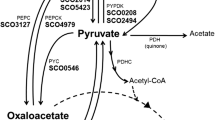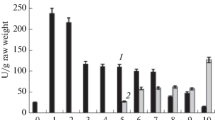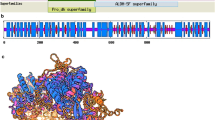Abstract
A cDNA was identified using an oligonucleotide designed by comparing the sequences of bacterial and yeast pyruvate decarboxylase. The sequence of the cDNA identified by the oligonucleotide contained an open reading frame that encoded a protein of 65 kDa that was similar in sequence to bacterial and yeast pyruvate decarboxylase. This protein was selectively precipitated by an antiserum specific for maize PDC. Northern-blot analysis shows that PDC mRNA is anaerobically induced. Southern-blot analysis of maize genomic DNA indicated that the maize PDC gene has a single or low copy number.
Similar content being viewed by others
References
Birnstiel ML, Busslinger M, Sturb K: Transcription termination and 3′ processing: the end is in site! Cell 41: 349–359 (1985).
Blake MS, Johnston KH, Russell-Jones GJ, Gotschlich EC: A rapid, sensitive method for detection of alkaline phosphatase-conjugated anti-antibody on western blots. Anal Biochem 136: 175–179 (1984).
Bradford MM: A rapid and sensitive method for the quantization of microgram quantities of protein utilizing the principle of protein dye-binding. Anal Biochem 72: 248–254 (1986).
Brumbaugh JA, Middendorf LR, Grone DL, Ruth JL: Continuous, on-line DNA sequencing using oligonucleotide primers with multiple fluorophores. Proc Natl Acad Sci USA 85: 5610–5614 (1988).
Conway T, Osman YA, Konnan JI, Hoffman EM, Ingram LO: Promoter and nucleotide sequences of the Zymomonas mobilis pyruvate decarboxylase. J Bact 169: 949–954 (1987).
Dennis Es, Gerlach WL, Walker JC, Lavind M, Peacock WJ: Anaerobically regulated aldolase gene of maize. A chimaeric origin? J Mol Biol 202: 759–767 (1988).
Devereux J, Haeberli P, Smithies O: A comprehensive set of sequence analysis programs for the VAX. Nucleic Acids Res 12: 387–395 (1984).
Ellis JG, Llyewellyn DJ, Dennis ES, Peacock WJ: Maize Adh1 promoter sequences control anaerobic regulation: addition of upstream promoter elements from constitutive genes is necessary for expression in tobacco. EMBO J 6: 11–16 (1987).
Ferl RJ, Dlouhy SR, Schwartz D: Analysis of maize alcohol dehydrogenase by native-SDS two dimensional electrophoresis and autoradiography. Mol Gen Genet 169: 7–12 (1979).
Freeling M: Simultaneous induction by anaerobiosis or 2,4-D of multiple enzymes specified by two unlinked genes: Differential ADH1-ADH2 expression in maize. Mol Gen Genet 127: 215–227 (1973).
Hake S, Kelley PM, Taylor WC, Freeling M: Coordinate induction of alcohol dehydrogenase I, aldolase and other anaerobic RNAs in maize. J Biol Chem 260: 5050–5054 (1985).
Hoffman NE, Bent AF, Hanson AD: Induction of lactate dehydrogenase isozymes by oxygen deficit in barley root tissue. Plant Physiol 82: 658–663 (1986).
Kellerman E, Seeboth PG, Hollenberg CP: Analysis of the primary structure and promoter function of a pyruvate decarboxylase gene (PDC1) from Saccharomyces cervisiae. Nucl Acids Res 14: 8663–8977 (1986).
Kelley PM, Freeling M: Anaerobic expression of maize glucose phosphate isomerase I. J Biol Chem 259: 673–677 (1984).
Kelley PM, Freeling M: Anaerobic expression of maize fructose 1,6-diphosphate aldolase. J Biol Chem 259: 14180–14183 (1984).
Kelley PM, Tolan DR: The complete amino acid sequence for the anaerobically induced aldolase from maize derived from cDNA clones. Plant Physiol 82: 1076–1080 (1986).
Kimmerer TW: Alcohol dehydrogenase and pyruvate decarboxylase activity in leaves and roots of eastern cottonwood (Populus deltoides Bartr.) and soybean (Glycine max L.). Plant Physiol 84: 1210–1213 (1987).
Kozak M: Possible role of flanking nucleotides in recognition of the AUG initiator codon by eukaryotic ribosomes. Nucl Acids Res 9: 5233–5252 (1981).
Laemmli UK: Cleavage of structural proteins during the assembly of head of bacteriophage T4. Nature 227: 680–685 (1970).
Laszlo A: Characterization of an Inducible Enzyme: Maize Pyruvate Decarboxylase. Ph. D. Thesis, University of California, Berkeley. University Microfilms International, Ann Arbor, MI (1981).
Laszlo A, StLawrence P: Parallel induction and synthesis of PDC and ADH in anoxic maize roots. Mol Gen Genet 192: 110–117 (1983).
Lee TC, Langston-Unkefer PJ: Pyruvate decarboxylase from Zea mays L. I. Purification and partial characterization from mature kernels and anaerobically treated roots. Plant Physiol 79: 242–247 (1985).
Maniatis T, Fritsch EF, Sambrook J: In: Molecular Cloning: A Laboratory Manual, pp. 213–246. Cold Spring Harbor Laboratory, Cold Spring Harbor, NY (1982).
Neale AD, Scopes RK, Wettenhall RE, Hoogenraad NJ: Pyruvate decarboxylase of Zymomonas mobilis; Isolation, properties, and genetic expression in Escherichia coli. J Bact 169: 1024–1028 (1987).
Okimoto R, Sachs MM, Porter EK, Freeling M: Patterns of polypeptide synthesis in various maize organs under anaerobiosis. Planta 150: 89–94 (1980).
Rave N, Crkvenjakov R, Boedtker H: Identification of procollagen mRNAs transferred to diazobenzyloxymethyl paper from formaldehyde agarose gels. Nucl Acids Res 6: 3559–3567 (1979).
Roberts JKM, Wemmer D, Ray PM, Jardetzky O: Regulation of cytoplasmic and vacuolar pH in maize root tips under different experimental conditions. Plant Physiol 69: 1344–1347 (1982).
Sachs MM, Freeling M, Okimoto R: The anaerobic proteins of maize. Cell 20: 761–767 (1980).
Schmitt HD, Ciriacy M, Zimmermann FK: The synthesis of yeast pyruvate decarboxylase is regulated by large variations in the messenger RNA level. Mol Gen Genet 192: 247–252 (1983).
Smith AM, apRees T: Effects of anaerobiosis on carbohydrate oxidation by roots of Pisum sativum. Phytochemistry 18: 1453–1458 (1979).
Springer B, Werr W, Starlinger P, Bennett DC, Zololica M, Freeling M: The Shrunken gene on chromosome 9 of Zea mays is expressed in various plant tissues and encodes an anaerobic protein. Mol Gen Genet 205: 461–468 (1986).
Shure M, Wessler S, Fedoroff N: Molecular identification and isolation of the Waxy locus in maize. Cell 35: 225–233 (1983).
Wignarajah K, Greenway H: Effect of Anaerobiosis on Activities of alcohol dehydrogenase and pyruvate decarboxylase in roots of Zea mays. New Phytol 77: 575–584 (1976).
Zehender H, Trescher D, Ullrich J: Improved purification of pyruvate decarboxylase from wheat germ, its partial characterization and comparison with the yeast enzyme. Eur J Biochem 167: 149–154 (1987).
Author information
Authors and Affiliations
Rights and permissions
About this article
Cite this article
Kelley, P.M. Maize pyruvate decarboxylase mRNA is induced anaerobically. Plant Mol Biol 13, 213–222 (1989). https://doi.org/10.1007/BF00016139
Received:
Accepted:
Issue Date:
DOI: https://doi.org/10.1007/BF00016139




